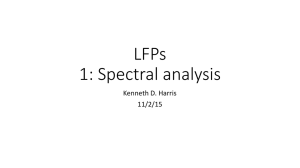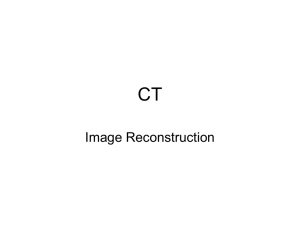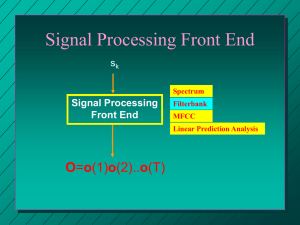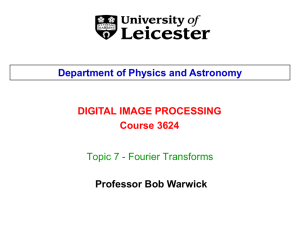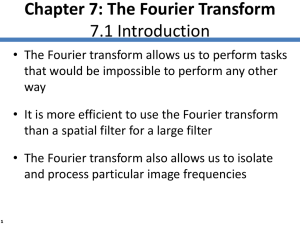Fourier transform
advertisement
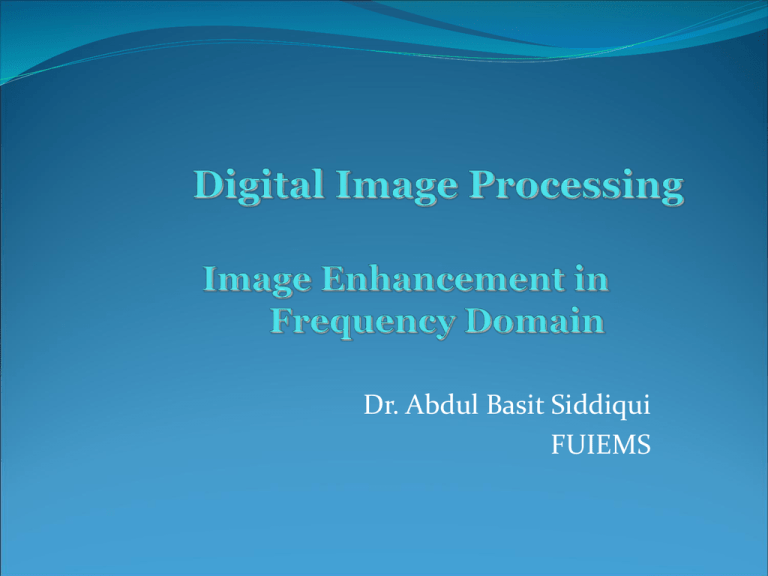
Dr. Abdul Basit Siddiqui FUIEMS Quiz Time 30 min. How the coefficents of Laplacian Filter are generated. Show your complete work. Also discuss different versions of Laplacian Filter. Applay the 3x3 laplacian filter on the following piece of an Image f(x,y). What will be its effect. 4/13/2015 90 0 23 45 45 20 43 78 12 50 12 21 12 30 32 37 60 35 58 89 70 91 80 10 90 2 Introduction 4/13/2015 3 Background (Fourier Series) Any function that periodically repeats itself can be expressed as the sum of sines and cosines of different frequencies each multiplied by a different coefficient This sum is known as Fourier Series It does not matter how complicated the function is; as long as it is periodic and meet some mild conditions it can be represented by such as a sum It was a revolutionary discovery 4/13/2015 4 Introduction to DFT • The Fourier Transform is an important image processing tool which is used to decompose an image into its sine and cosine components. • The output of the transformation represents the image in the Fourier or frequency domain, while the input image is the spatial domain equivalent. • In the Fourier domain image, each point represents a particular frequency contained in the spatial domain image. 4/13/2015 5 Introduction to DFT • The Fourier Transform is used in a wide range of applications, such as image analysis, image filtering, image reconstruction and image compression. • The DFT is the sampled Fourier Transform and therefore does not contain all frequencies forming an image, but only a set of samples which is large enough to fully describe the spatial domain image • The number of frequencies corresponds to the number of pixels in the spatial domain image, i.e. the image in the spatial and Fourier domain are of the same size. 4/13/2015 6 4/13/2015 7 Background (Fourier Transform) Even functions that are not periodic (but whose area under the curve is finite) can be expressed as the integrals of sines and cosines multiplied by a weighing function This is known as Fourier Transform A function expressed in either a Fourier Series or transform can be reconstructed completely via an inverse process with no loss of information This is one of the important characteristics of these representations because they allow us to work in the Fourier Domain and then return to the original domain of the function 4/13/2015 8 Fourier Transform • ‘Fourier Transform’ transforms one function into another domain , which is called the frequency domain representation of the original function • The original function is often a function in the Time domain • In image Processing the original function is in the Spatial Domain • The term Fourier transform can refer to either the Frequency domain representation of a function or to the process/formula that "transforms" one function into the other. 4/13/2015 9 Our Interest in Fourier Transform • We will be dealing only with functions (images) of finite duration so we will be interested only in Fourier Transform 4/13/2015 10 Applications of Fourier Transforms 1-D Fourier transforms are used in Signal Processing 2-D Fourier transforms are used in Image Processing 3-D Fourier transforms are used in Computer Vision Applications of Fourier transforms in Image processing: – – – – – 4/13/2015 Image enhancement, Image restoration, Image encoding / decoding, Image description 11 One Dimensional Fourier Transform and its Inverse The Fourier transform F (u) of a single variable, continuous function f (x) is Given F(u) we can obtain f (x) by means of the Inverse Fourier Transform 4/13/2015 12 One Dimensional Fourier Transform and its Inverse The Fourier transform F (u) of a single variable, continuous function f (x) is Given F(u) we can obtain f (x) by means of the Inverse Fourier Transform 4/13/2015 13 Discrete Fourier Transforms (DFT) 1-D DFT for M samples is given as The Inverse Fourier transform in 1-D is given as 4/13/2015 14 Discrete Fourier Transforms (DFT) 1-D DFT for M samples is given as The inverse Fourier transform in 1-D is given as 4/13/2015 15 Two Dimensional Fourier Transform and its Inverse The Fourier transform F (u,v) of a two variable, continuous function f (x,y) is Given F(u,v) we can obtain f (x,y) by means of the Inverse Fourier Transform 4/13/2015 16 2-D DFT where f(a,b) is the image in the spatial domain and the exponential term is the basis function corresponding to each point F(k,l) in the Fourier space 4/13/2015 17 Fourier Transform 4/13/2015 18 2-D DFT 4/13/2015 19 Image Restoration • In many applications (e.g., satellite imaging, medical imaging, astronomical imaging, poor-quality family portraits) the imaging system introduces a slight distortion • Image Restoration attempts to reconstruct or recover an image that has been degraded by using a priori knowledge of the degradation phenomenon. • Restoration techniques try to model the degradation and then apply the inverse process in order to recover the original image. 4/13/2015 20 Image Restoration • Image restoration attempts to restore images that have been degraded – Identify the degradation process and attempt to reverse it – Similar to image enhancement, but more objective 4/13/2015 21 A Model of the Image Degradation/ Restoration Process 4/13/2015 22 A Model of the Image Degradation/ Restoration Process • The degradation process can be modeled as a degradation function H that, together with an additive noise term η(x,y) operates on an input image f(x,y) to produce a degraded image g(x,y) 4/13/2015 23

